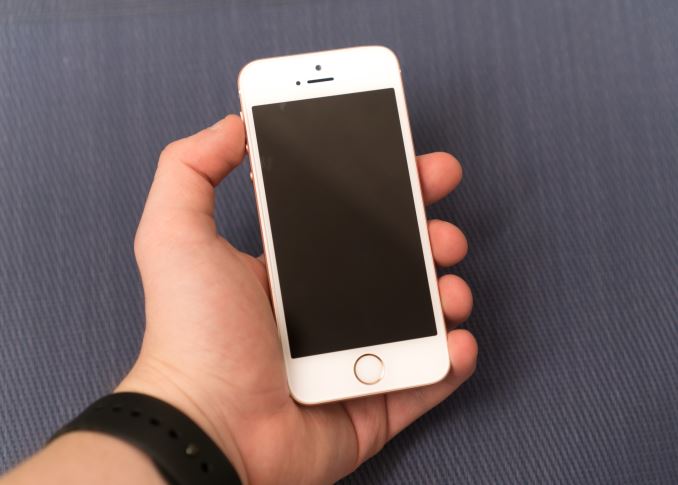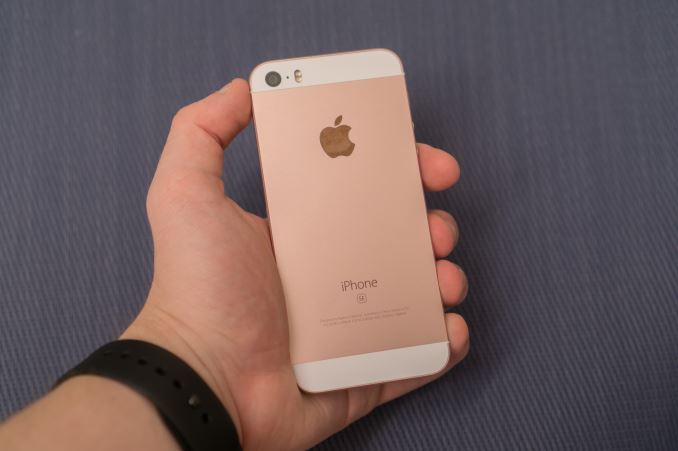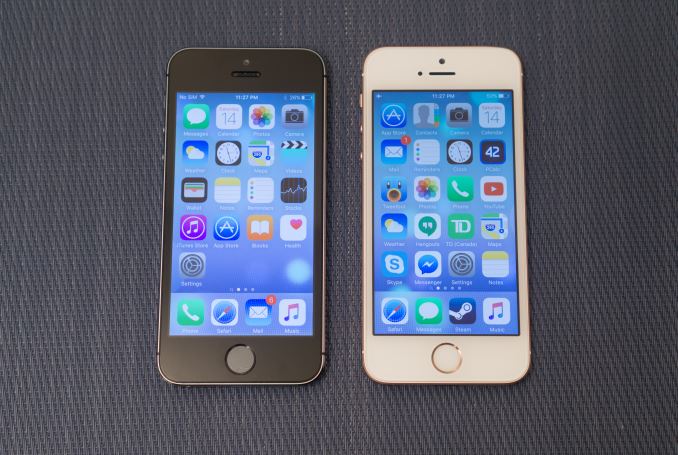The iPhone SE Review
by Brandon Chester on May 16, 2016 8:00 AM EST- Posted in
- Smartphones
- Apple
- Mobile
- iPhone
- iPhone SE

With the launch of the iPhone 6, Apple had finally tapped into the latent demand for bigger iPhones, and as a result we saw some record-setting quarters from Apple. However, at the same time by moving to a larger display size there was a fairly sizeable audience that was being left behind. While a 4.7" phone is generally a one-handed device for most, there's definitely a sizeable portion of iPhone users that bought the iPhone 5s because the 4-inch size was the largest they could go without facing problems with one-handed usability.
The other challenge that Apple faced was their need to be more competitive at the mid-range. For a lot of people, 300-400 USD is pretty much the most that they can afford to pay for a smartphone, and as a result the value proposition for an iPhone flagship that was two generations behind the latest was increasingly weak in markets like India and China, especially when Xiaomi and Huawei were often shipping the latest and greatest hardware for similar prices. While margin might not be as high in this segment of the market, the volume here can definitely compensate.
With these two issues in mind, this brings us to Apple's newest iPhone, the iPhone SE. As Apple's smaller iPhone, the iPhone SE has two functions. It provides a viable option for users who want a smaller iPhone, and it allows Apple to sell at price points that they can't reach with their larger and more expensive iPhones. This is especially key with Apple's push to increase sales in emerging markets like China and India, as for many people the price of the iPhone 6s and 6s Plus makes them inaccessible. As you'll see, the iPhone SE brings the price of a new iPhone lower than it has ever been before.
It's probably no surprise at this point, but the iPhone SE is going to be a familiar phone. With essentially the same chassis as the iPhone 5s, the iPhone SE marks the first time that Apple has used the same design in three generations of an iPhone. While the iPhone SE is the same as the iPhone 5s on the outside, Apple has made some serious improvements to what's on the inside. Below you can see how Apple's new 4-inch smartphone compares to its predecessor, and to Apple's flagship iPhone, the iPhone 6s.
| Apple iPhone Line | |||
| Apple iPhone 5s | Apple iPhone SE | Apple iPhone 6s | |
| SoC | Apple A7 2 x 1.3GHz Apple Cyclone |
Apple A9 2 x 1.85GHz Apple Twister |
|
| GPU | PowerVR GX6450 | PowerVR GT7600 | |
| RAM | 1GB LPDDR3 | 2GB LPDDR4 | |
| Display | 4.0-inch 1136 x 640 IPS LCD |
4.7-inch 1334 x 750 IPS LCD |
|
| Size / Mass | 123.8 x 58.6 x 7.6 mm 112 grams |
123.8 x 58.6 x 7.6 mm 113 grams |
138.3 x 67.1 x 7.1 mm 143 grams |
| Camera | Rear Facing 8MP iSight with 1.5µm pixels + True Tone Flash |
Rear Facing 12MP iSight with 1.22µm pixels + True Tone Flash |
|
| Front Facing 1.2MP f/2.4 |
Front Facing 5MP f/2.2 + Retina Flash | ||
| Storage | 16GB 32GB 64GB |
16GB 64GB |
16GB 64GB 128GB |
| I/O | Apple Lightning connector, 3.5mm headset | ||
| WiFi | 2.4/5GHz Dual Band 1x1 802.11n BT 4.2 |
2.4/5GHz Dual Band 1x1 802.11ac BT 4.2, NFC |
2.4/5GHz Dual Band 2x2 802.11ac BT 4.2, NFC |
| Price | 16GB: $449 | 16GB: $399 64GB: $499 |
16GB: $649 64GB: $749 128GB: $849 |
Even if I hadn’t put any images on this page, it’s likely that you’d be able to visualize the design of the iPhone SE. At its core it’s a design that has been around since 2012, with a few tweaks having been made along the way. Despite that, it’s a design that still holds up, and I think the HTC One M7 is the only other device from that time that you can really say that about today.
From an aesthetic point of view, the chassis style of the iPhone 5, 5s, and SE is still one of my favorite smartphone designs. The flat sides, chamfered edges, circular volume buttons, and antenna inserts all make for an elegant look, and in my opinion it’s actually a more visually appealing design than that of the iPhone 6/6s which uses injected plastic antenna lines, chiclet buttons, and a camera hump. On the flip side, the iPhone 6 definitely comes ahead as far as ergonomics are concerned. The flat sides and chamfered edges of the SE make for an elegant design, but when you make a phone with flat edges on all sides you inevitably end up with a somewhat brick-like device that doesn’t conform well to the human hand. The fact that the iPhones with this design have all had displays of 3.5” or 4” lets them get away with this due to their smaller profile, but there’s no denying that the curved iPhone 6 design has a better in-hand feel.
Almost nothing has changed externally going from the iPhone 5s to the SE. The dimensions are unchanged, and the mass has only gone up by a single gram. I've only noticed two changes. The first is the elimination of the regulatory logos from the rear of the chassis, and the second is a change from a shiny chamfered edge to one with a matte finish that matches the rest of the chassis. Beyond that, and the inclusion of the new rose gold color, the design is unchanged from the iPhone 5s.
Going with an older design has some advantages and drawbacks, and some of these end up being the same aspect viewed from two different perspectives. For example, with the SE being a less expensive iPhone in an older design, Apple isn’t pushed to make it the thinnest possible device. While this is arguably a bad thing by Apple’s own standards, it does mean that there’s more space for the battery than if Apple were to slim down the device, and you don’t get a camera hump. The older design does come with a fairly large bezel on the left and right sides of the screen relative to the size of the display itself, and the black space between the white face plate and the actual screen is significantly thicker than on newer iPhones which does make the design look a bit dated.
The iPhone SE may be part of a larger general trend where smartphone designs don’t change as significantly from generation to generation now that the market is maturing. In many ways, having to change your design every year is actually not a good thing, as it implies that your past design had significant flaws that necessitated a brand new one. Samsung’s Galaxy S7 is a good example of this, with the design changes being minimal but noticeable refinements on the existing Galaxy S6 which had a much better design than its predecessors. Good design is long-lasting, and much like how the truly good laptops on the market can keep the same design for many years, smartphones will likely begin to do so as well, with smaller refinements to accommodate new features, and in Apple’s case, a continued reduction in device thickness.
Ultimately, the design of the iPhone 5 and 5s still works, and there aren’t any significant flaws with it that would necessitate a change in design. With it being a well-known and, as Apple puts it, beloved design, it’s not surprising to see it return for a third time in the iPhone SE. While there are some small tweaks like changing the chamfered edge from a reflective to a matte finish, the core design is the same one that Apple’s existing owners of 4” iPhones know and love.












138 Comments
View All Comments
msork - Monday, May 16, 2016 - link
I bought one. I love the 4" phone.zeeBomb - Monday, May 16, 2016 - link
Dang this review took ages, but nice.Brandon Chester - Monday, May 16, 2016 - link
I have to apologize for the time it took, it's probably two weeks longer than it should have taken. I was in the middle of moving to a new city and also starting a new job during the course of the review which is what caused the delays.zeeBomb - Tuesday, May 17, 2016 - link
Oh! No worries then. When life happens, all you can do is just adapt.Neonomide - Monday, May 16, 2016 - link
Bundling a 10-15W charger with the phone would be stupid, as the battery cycles would suffer. Charging a phone battery too fast takes a toll on battery life in the long run and that's the main reason Apple does not do it.TheinsanegamerN - Monday, May 16, 2016 - link
Doesnt seem to have affected my coworkers iphone 6 at all, despite him using a ipad charger.Apple's charging circuit should only let in as much amperage as the battery can take without suffering damage.
GC2:CS - Tuesday, May 17, 2016 - link
iPhone 6 can take up to 10W I think, not only for charging but also for powering itself. It charges a good few minutes faster than with 5W, the more you load the phone the bigger the difference.Plus iPhones take quite a bit more power for just charging.
What I find interesting that it can use up 5W to charge it's 6,21Wh battery much faster than 5S. That's deffinitelly in part that iPhone devices prior to 6 took some bit less less than 5W to charge, but still the difference is almost faulty looking to me.
Then we got MacBook and iPad Pro charging in 2 hours at 29W, 9,7" iPad Pro supposedly charging super quick (~3 hours) even with it's included (pooor poor 10W) charger, great for a tablet, not ultra quick, but there is Apple smart battery case which can take some super quick charging times when conected to 10/12W iPad adapters.
The question is, what will happen when you connect this phone to a 12W charger ? Can it take more power in like iPhone 6 does ? Does it have that mysterious battery tech like SBC , which gets soaked quickly ?
Not to say Apple wants to unexpectedly come up with fast charging, I think they are going after it for some time, but what does that mean for the next iPhone... Ultra iCharge confirmed ?
thestinkinggenius - Monday, May 16, 2016 - link
I own this phone and two things that drive me nuts are:1: Bluetooth calls sound like crap - this is a known issues and is being fixed in the 9.3.2 beta
2: Cell reception is sub par - I work in a basement office and regularly get disconnected in the middle of a call (I also use a Nexus 5x and never get disconnected). If I turn on Wifi calling it still happens.
sfwineguy - Monday, May 16, 2016 - link
I'm very glad to read the details of this comment (mainly re the Bluetooth fix). I own this phone - it replaced a 4S purchased upon release. I was motivated enough by this issue to register with Anandtech in order to comment!The phone in general seems quite good, but the Bluetooth is unusable in my car (a 2012 VW that worked great with my 4S and every other phone) and in the few other cars in which I've tried it. Bluetooth has worked fine with a Mini Jambox. Apple has consistently denied responsibility for this problem to me and (if you believe the internet) many other users, but I've seen online that they have also at times stated that they are aware of the problem and working on a fix. I'm hoping the issue is software and not hardware. If they roll out a fix soon, it's no problem for me as a consumer; if not, the phone is very nearly worthless. I advise anyone buying this to immediately test it with your Bluetooth before giving up your old phone.
sfwineguy - Tuesday, May 17, 2016 - link
Follow up: downloaded the update and have used phone on Bluetooth in my car. Better and good enough to use; still not as good as my old iPhone 4S or many older phones: Overall, happy to have the update. Phone itself has proven very usable. Love the size, and yes, the bezels are too big and outdated; would be great to shrink the bezels for either same overall size and more screen or same screen and smaller overall size. Using what they had, though, is probably too deliciously profitable for Apple and suppliers to pass up.